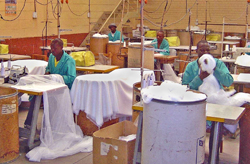You are here » Home » Telling Our Story
Case Study
A new technology benefits businesses and people
Better Nets Trap Malarial Mosquitoes

| |
Photo: NetMark
|
|
This manufacturer in Kenya now has access to technology to make Long-Lasting Insecticide Nets.
“I came to this meeting thinking that I would never have [access to] Long-Lasting Insecticide Net technology. Now I find I am shopping among different options,” said a net manufacturer from Nigeria.
|
Challenge
More than 2 million people die from malaria each year, and those most severely affected by the disease are children under 5 years old and pregnant women. Although there is no guaranteed way to prevent malaria, certain methods have proven very effective. Insecticide-treated bed nets are recognized as being a key component of malaria prevention. These nets, which protect people sleeping from malarial mosquitoes, provide much more robust protection against malaria than non-treated nets. Treated nets repel and even kill mosquitoes that approach. Yet the nets need to be re-treated every six months. Few Africans can afford to have their nets retreated that often. As a result, most nets go untreated well beyond those six months.
Initiative
There is a new technology that can address this problem: Long-Lasting Insecticide Nets (LLIN). By incorporating insecticide into the netting during production, the nets can repel and kill mosquitoes for four to five years. However, for some time, there was no process for mass-producing these nets, leading to a major supply shortage. When a mechanized treatment process was finally developed, the technology was not publicly available. USAID worked with the firms that had developed the technology to place it in the public domain, enabling companies everywhere that produce nets, particularly those in Africa, to use it.
Results
In 2005, USAID brought together major African net manufacturers, owners of LLIN technologies, and groups supporting the technology’s expansion at a meeting in Nairobi, Kenya. The manufacturers were excited about the technology’s importance and potential, and they are working with USAID to seek ways to incorporate it into production. Several manufacturers will invest in new equipment and staff training, and some have even joined the World Health Organization’s Roll Back Malaria Project. Making LLIN technology available to all will bring tremendous benefits to manufacturers, their employees, and, most importantly, to millions of Africans who will be spared the devastating effects of malaria.
Print-friendly version of this page (523kb - PDF)
Click here for high-res photo
Back to Top ^ | 

